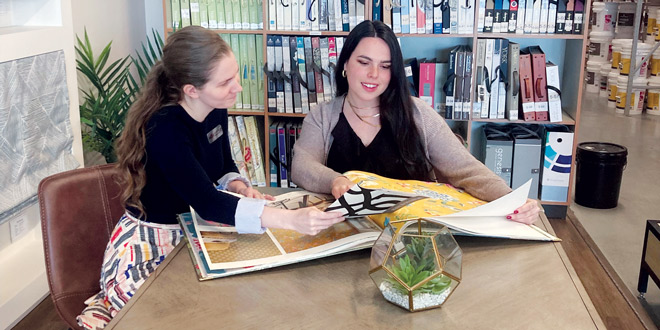Design services are a convenient entry point for customers and provide retailers another way to guide customers through home improvement projects and fulfill their design dreams. When executed correctly, these services boost sales and set operations apart from other businesses.
Patrick Smith, president of Regal Paint Centers, began working at the business part time in 2000 before starting full time after finishing college. His father, Brian Smith, purchased the first Regal Paint Centers location in 1986 with his business partner Jim Palmer. Since then, the business has expanded into 11 locations in the greater Washington, D.C. metropolitan area. In 2018, the company began focusing its efforts on design services and has since seen increased sales, improved customer satisfaction and more. Hardware Retailing spoke with Smith about why he reinvested in design services, how the company’s services work and his best practices for implementing similar offerings at your operation.
A Reevaluation
Regal Paint Centers introduced design services when it acquired its sixth location in 2004. The Annapolis, Maryland, store already employed design consultants, so Smith says he and his team made the decision to keep them.
“The designers were paid hourly for their consultant work within the store,” Smith says. “For in-home color consultations, designers were allowed to market themselves, charge their own rates and collect revenues entirely separate from our operation.”
Over the next decade, Smith and his team considered the value the design consultants offered to the operation. He connected the dots and realized the design services in the Annapolis location were thriving because it is an affluent area with a customer base looking for support and advice.
“It took a few years for us to sit down and discuss the strategic value of having design consultants in our business,” Smith says. “We began looking at our entire operation more critically, discussing what strategies worked in different markets and what stores they could be expanded into.”
Along with internally analyzing design services, Smith made a point to investigate externally as well.
“After speaking with consumers and dealers, I realized one of the biggest pain points for our customers, whether they are executing a paint project themselves or hiring a professional, is picking a color,” Smith says. “This realization allowed us to understand the value of design services in relation to assisting our customers and making the design process as effortless as possible.”
In 2014 the operation began to expand design services to additional locations, and in 2018 Smith and his team again reevaluated the design services in their operations and saw an opportunity to reconstruct them to better benefit the operation.
“We came to realize that we weren’t in control of what we’ve found to be critical components of successful design services,” Smith says. “We allowed customers to meet our designers, start a relationship and then walk away with the designers with no guaranteed benefit or sale for our business.”
This awareness led to the creation of a standardized process for all design services. Home consultations began running through the business, not the designers, and policies were put in place to make sure customers had clear expectations of services and a full understanding of what they include, Smith says.
“We realized that design services need to be treated like a product,” he says. “They need to be sold and promoted as valuable resources.”
Insight and focus led to further expansion into complementary products and services, with the business expanding into window treatments and wallcoverings in 2020, in addition to paint selection design services.
“Customers who want to paint sometimes want to wallpaper a room, and when it comes to window treatments, we’ve found our customers don’t want to start another conversation with a new business or designer to find the right product,” Smith says. “Offering products and services that can be wrapped into a more comprehensive design project increases sales and delivers higher levels of customer satisfaction.”
A Reawakening
Currently, four Regal Paint Centers offer free in-store design services and paid at-home consultations, with plans in place to expand services into four additional locations.
“We market certain hours within each store for the in-store design services, typically Thursday, Friday, Saturday and some of our higher traffic days,” Smith says. “Customers often bring color chips, fabric swatches or inspirational images into our stores to obtain complimentary color and design advice.”
In theory, this means a customer could have a designer to themselves for multiple hours, but more often a designer is shared between multiple customers during this process, which is sometimes all that is necessary.
“Occasionally customers come into our stores and just need a sounding board to bounce their ideas off of,” Smith says. “They need reassurance before moving forward with a project, and the in-store design services provide the necessary affirmation, often leading to an immediate sale.”
Other times, customers need more help in the design process and require more in-depth consultations, with the free in-store design consultation serving as a starting point and a chance for the designer to develop a relationship with the customer.
“It can be daunting for customers to jump right into a paid design service, especially without knowing the designers’ style or personality,” Smith says. “The majority of our customers who purchase the paid service meet the designer in the store, establish a relationship and realize the need for a designer to be in their home to gain better insight and provide a custom-tailored recommendation.”
In-home consultations are more personalized and in-depth because designers gain a better understanding of the space and what the customer is looking to achieve.
“It can be challenging to discern the true feel of a space a customer is trying to decorate through a picture,” Smith says. “Designers need to be in the space to see where limitations may lie, such as with lighting, to provide the best advice.”
After the designer has analyzed the space and consulted with the customer, designers provide a completed color schedule and paint suggestions. When necessary, designers also offer painter recommendations, promoting contractors who purchase from their store, which connects paint sales to the design work, Smith says. Through this process and the mutual trust built between the designer and the customer, smaller projects often expand.
“Project expansion doesn’t happen in the store as often because designers’ can’t see the entire space, and they haven’t had time to build the relationship and trust to the level necessary to successfully grow a project,” Smith says. “Projects sometimes double or triple in size once our designers are in homes. They make compelling cases about complementary colors flowing from room to room, providing a more cohesive house design.”
A Revival
Expanded projects are not the only benefit of design services; they also allow retailers to better market their business and grow brand awareness in local markets.
Regal Paint Centers’ staff promotes design services through posters and display cards in design areas, exterior store signage and brochure distribution. The operation’s monthly e-newsletter often includes design services marketing as well, through a design consultant spotlight or the promotion of a design event. Regal Paint Centers’ website also has design services information, along with a place customers can request additional information, which provides an opportunity for staff to reach out and chase leads, Smith says.
By marketing design services and growing the Regal Paint Centers brand, the operation drives sales.
“The margins are low for in-home consultations themselves,” Smith says. “The benefit is found in the ensuing product sales. Advertisements about design services that assist with color selection resonate with retail customers, increasing the impact.”
When designers connect customers with contractors who purchase from the business, they increase product sales. Along with a boost in product sales from those contractors, Regal Paint Centers is building stronger relationships with pros through its design services, increasing and expanding professional our business, Smith says.
Designers are also often the first point of contact with customers, which can be extremely beneficial to a business.
“When a customer arrives at one of our stores looking for assistance, our designers greatly influence that customer’s first impression,” Smith says. “It’s a huge opportunity to impress the customer and for designers to show off their expertise.”
Showing apt skill and knowledge during initial interactions with customers builds trust and confidence, showcasing excellent customer service that encourages increased sales, returning customers and word-of-mouth advertising.
Not only do design services improve customer service and satisfaction, boost product sales, grow professional business, encourage project expansion and strengthen an operation’s marketability, they are also a valuable business differentiator.
“In a world where a lot of purchasing is completed virtually, there’s no substitute for in-person relationships and interactions,” Smith says. “In-store designers deliver the superior service that customers are looking for, setting an operation apart from competitors.”
3 Best Practices for Employing High Quality Staff
Because designers serve as a first of impression of the business, those positions must be filled by exceptional employees. Discover how Smith and his team approach hiring in their operation.
-
Support your current employees.
Understanding what is important to current employees and establishing a positive relationship with them can lead to them encouraging their personal contacts to join the business, Smith says. -
Build an attractive company culture.
People want to enjoy coming to work. Creating a positive work environment and demonstrating it through employee and customer interactions can go a long way in hiring, Smith says. -
Embrace schedule flexibility.
Making concessions for the right person is almost always worth it; when hiring and scheduling are rigid, retailers may lose the opportunity to find a better fit, which doesn’t always give you the best result, Smith says.
4 Social Media Tips for Design Services
An integral component of a successful design service is exceptional marketing. Social media is a simple, free strategy to utilize when marketing design services. Discover best practices to consider when getting started.
Create the perfect post. To catch the attention of your followers, make sure to include informative and creative copy, a great image, a link to your website or other source and a clear call to action when possible.
Join the conversation. Respond to comments and converse with your customers and other local businesses. There’s great value in being present and showing you care about what your followers have to say.
Add value. Don’t bog down your social media pages with too many promotions. Share unique and interesting content—like before and after photos of design projects—to add variety, lift engagement and allow promotional posts to better stand out.
Track your efforts. Pay attention to your most popular and unpopular posts and consider that information. Evaluating your social media analytics helps you improve and provide your followers with the content they want.
Source: NHPA Social Media Toolkit
Eye for Design
Gain insight into 2022 design trends to stay up to date on customers’ needs here.
 Hardware Retailing The Industry's Source for Insights and Information
Hardware Retailing The Industry's Source for Insights and Information






